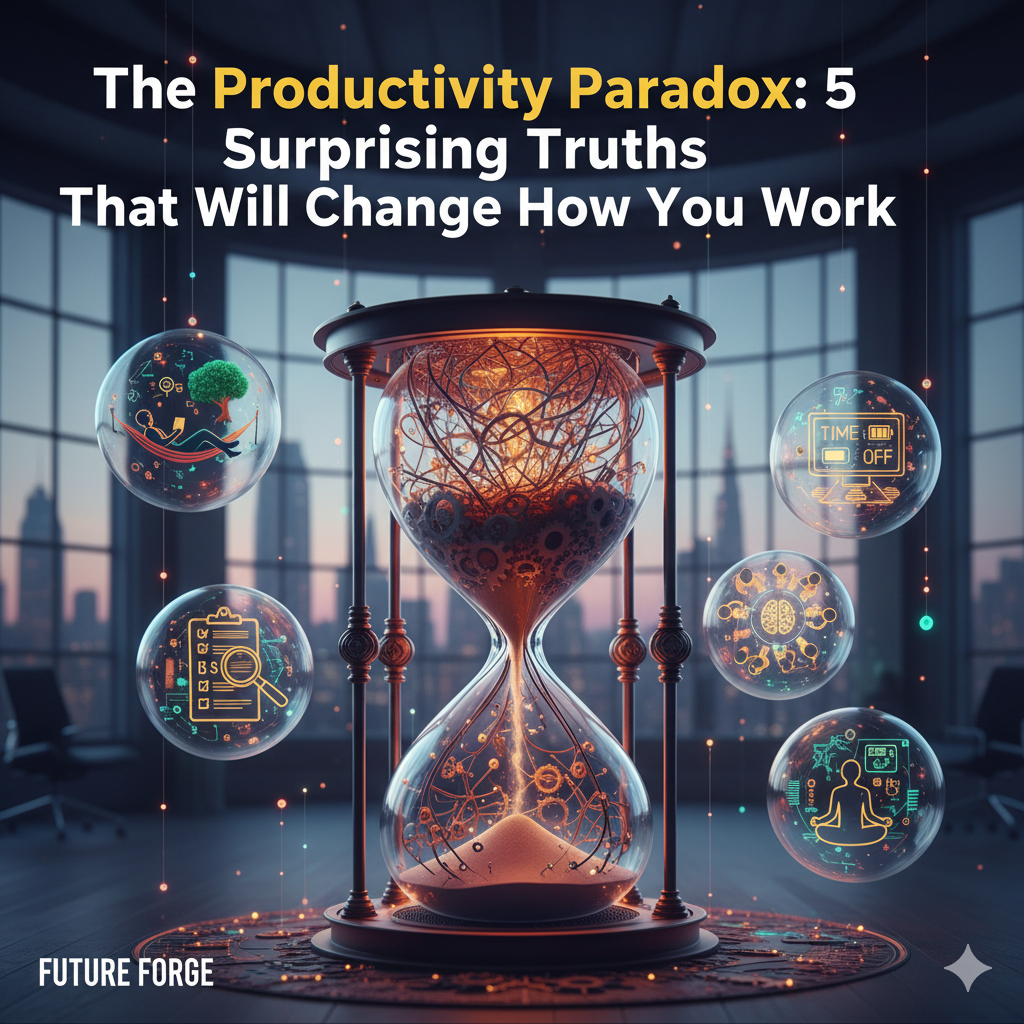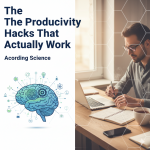Introduction: The Modern “Productivity Trap”
You end the day exhausted. Your calendar was packed, your inbox is (almost) clear, and you were busy from the moment you started. Yet, there’s a nagging feeling that despite all the activity, you didn’t make meaningful progress on what truly matters. If this sounds familiar, you’ve experienced the modern productivity trap.
In today’s “hustle” culture, busyness has become a benchmark for success. The constant pressure of our “culture of connectivity” creates an expectation to be “always-on,” responding to every notification and request instantly. But new research and workplace experiments are challenging these long-held beliefs. These findings aren’t just academic; they are early signals of a seismic shift in how elite organizations will define and measure performance in the coming decade. They suggest true productivity is a strategic recalibration—away from measuring inputs like hours and toward measuring high-value outputs generated during periods of peak cognitive performance.
This article explores five counter-intuitive truths about work that could fundamentally change how you see success.
Five Surprising Truths About Productivity
The Myth of Busyness: Why Activity Doesn’t Equal Achievement
The first step to escaping the productivity trap is understanding the crucial difference between being busy and being productive. Author Cal Newport provides a clear framework for distinguishing them with two types of work:
- Deep Work: Professional activities performed in a state of distraction-free concentration that push your cognitive capabilities to their limit. These efforts create new value, improve your skill, and are hard to replicate.
- Shallow Work: Non-cognitively demanding, logistical-style tasks, often performed while distracted. These efforts tend not to create much new value and are easy to replicate.
Constantly checking email and jumping between small tasks are hallmarks of shallow work. This is the hidden cost of a day filled with shallow work: every time you switch from a spreadsheet to an email, you leave a piece of your cognitive horsepower behind. This “attention residue,” as researcher Sophie Leroy calls it, is why a day of constant task-switching feels both exhausting and unproductive. You’re operating at a fraction of your capacity, creating a deceptive illusion of progress while true, deep work remains untouched.
The goal, therefore, should be to shift from completing many small tasks to achieving a “flow state”—those moments of deep focus where time seems to fade away. This shift requires a tactical change in how we structure our day. As one professional experimenting with this approach outlined, the key is to “write 1-2 big things on my to-do list instead of 10 small things” and to save mindless administrative tasks for the end of the day when cognitive energy is already low. Busyness is often just a deceptive proxy for value; true achievement is born from uninterrupted concentration.
The Surprising Truth: More Hours Can Mean Less Output
The belief that working longer hours directly translates to more output seems logical, but data suggests it’s a flawed assumption. A study from the IZA Institute of Labor Economics on call center agents revealed a powerful, counter-intuitive finding about the law of diminishing returns.
The key result was clear: as agents’ daily working hours increased, their average productivity decreased. Specifically, a 1% increase in hours worked led to only a 0.9% increase in output (the number of calls handled). This effect is attributed to worker fatigue, which can set in even in jobs where most employees work part-time. As agents worked longer, they became slower at handling each call.
Interestingly, the study also found a nuance. While the quantity of work decreased with longer hours, the quality of the calls saw a moderate increase. This suggests a potential trade-off workers make, consciously or not, between speed and quality as fatigue sets in. This data provides a stark example that simply adding more hours to the clock does not guarantee a proportional increase in achievement and may even reduce efficiency.
Your Brain is a Sprinter, Not a Marathon Runner
Our brains are not designed for eight hours of continuous, focused output. Pushing through mental exhaustion with sheer willpower is an unreliable and ineffective strategy for sustained performance because willpower is a finite resource that depletes throughout the day.
Instead, our brains operate on what are known as “ultradian rhythms”—natural cycles of peak focus and recovery. Research shows that after about 90 minutes of focused work, cognitive performance declines dramatically. We are built for intense bursts of effort followed by periods of genuine rest. Even the most accomplished experts in a field can rarely sustain more than four hours of intense, deep concentration per day. For novices, that number drops to about one hour.
To work with your brain instead of against it, adopt a sprint-based approach:
- The Pomodoro Technique: Work in a highly focused 25-minute sprint, followed by a 5-minute break.
- The 90/30 Rule: Engage in a 90-minute deep work session, followed by a 30-minute period of recovery and rest.
The Hidden Danger of Being “Always-On”: Invisible Burnout
Ignoring our brain’s natural sprint-and-recover cycles (our “ultradian rhythms”) isn’t just a bad habit; it’s the direct cause of the “invisible burnout” plaguing knowledge workers. By treating our minds like marathon runners, we create a constant, low-level cognitive debt that accrues daily, leading to the emotional exhaustion and loss of meaning that define this hidden crisis.
This phenomenon is a persistent mental exhaustion caused by the pressure of working without clear time limits. Unlike conventional burnout, its symptoms are often subtle and can be masked by a culture that glorifies high productivity. They include:
- Emotional and cognitive exhaustion.
- A loss of meaning and purpose in work.
- A gradual but significant decline in engagement and intrinsic motivation.
This condition is not a personal failing but a systemic issue arising from modern work expectations. The trend has been accelerated by the rise of remote work, which has further blurred the boundaries between our professional and personal lives. When the workspace shifts to our living rooms, work can feel inescapable, leading to a never-ending cycle of internalized exhaustion that often goes unrecognized until it becomes severe.
The 4-Day Workweek: A Miracle Cure… Or a Complicated Reality?
The Hype: A Resounding Success
Headlines have celebrated the four-day workweek as a revolutionary solution to burnout. The world’s largest trial in Britain was hailed as a “resounding success,” and the results were impressive. In the 61 participating companies, revenue largely stayed the same or grew, while employees reported being:
- 71% less burned out
- 39% less stressed
- 48% more satisfied with their jobs
An overwhelming 92% of companies decided to continue with the shorter week. As Kirsty Wainwright, general manager of the Platten’s restaurant participating in the trial, noted:
“Everyone is focused, everyone knows what they’re doing, everyone is refreshed… what it means is that they are coming into work with a better frame of mind and passing that on to obviously the clients and the public.”
The Reality: A Flawed Picture
However, a closer look at the data reveals a more complicated picture. Data scientist Liberty Vittert, testifying before the U.S. Senate, pointed out significant statistical flaws in these widely cited studies. Key issues include:
- Selection Bias: Companies that opt into these trials are often small, agile, and motivated to make it work, which doesn’t represent the broader economy.
- Self-Reported Data: The results rely on employees reporting on themselves, which is susceptible to bias.
- Government Subsidies: Some trials were supported by government funds. The Icelandic government, for example, spent nearly $30 million extra to hire more healthcare workers to make the shorter week viable.
Furthermore, mandating a shorter workweek can have unintended negative consequences. When France mandated a 35-hour week, many companies responded by hiring more part-time workers who received lower pay and fewer benefits. While the four-day workweek shows promise, it is not a one-size-fits-all solution, and its complexities are often lost in the hype.
Conclusion: Redefining Your Relationship with Work
The evidence is mounting: true productivity requires a fundamental shift away from a culture that rewards “doing more” and toward one that values strategic focus and intentional rest. If our brains are sprinters (Truth #3) and constant connectivity leads to invisible burnout (Truth #4), then the modern expectation of an 8-hour, always-on workday isn’t just inefficient—it’s fundamentally at odds with our biology and a direct path to diminished returns (Truth #2).
The future of elite performance won’t be defined by who can endure the most, but by who can strategically recover the best. The fundamental metric is shifting from hours logged to value created per unit of focused energy. The question is no longer “How much can you handle?” but “What systems will you build to protect your focus?”












